BMW X5 3.0I 2007 E70 Owner's Manual
Manufacturer: BMW, Model Year: 2007, Model line: X5 3.0I, Model: BMW X5 3.0I 2007 E70Pages: 272, PDF Size: 9.03 MB
Page 211 of 272
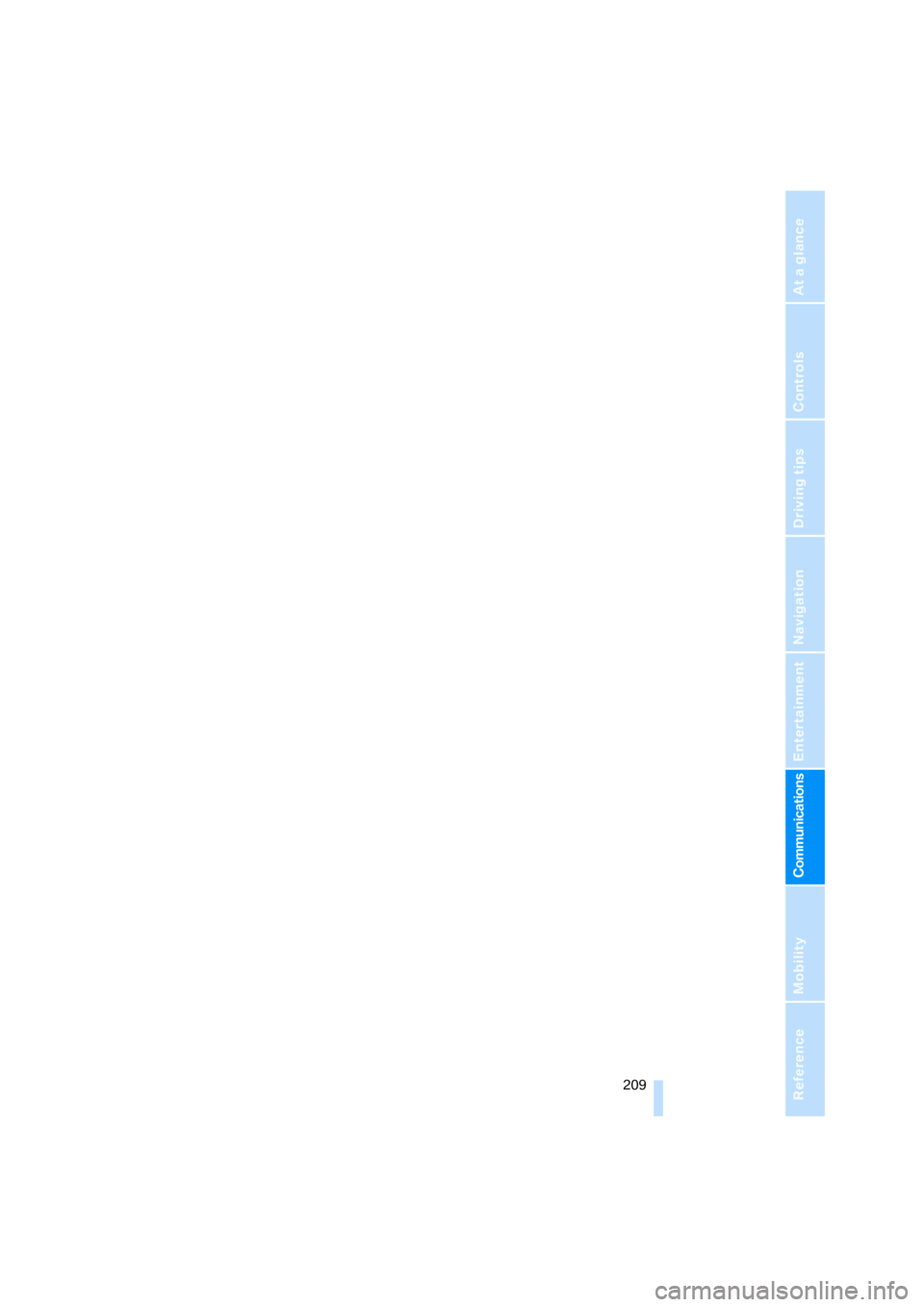
209
Entertainment
Reference
At a glance
Controls
Driving tips Communications
Navigation
Mobility
Page 212 of 272
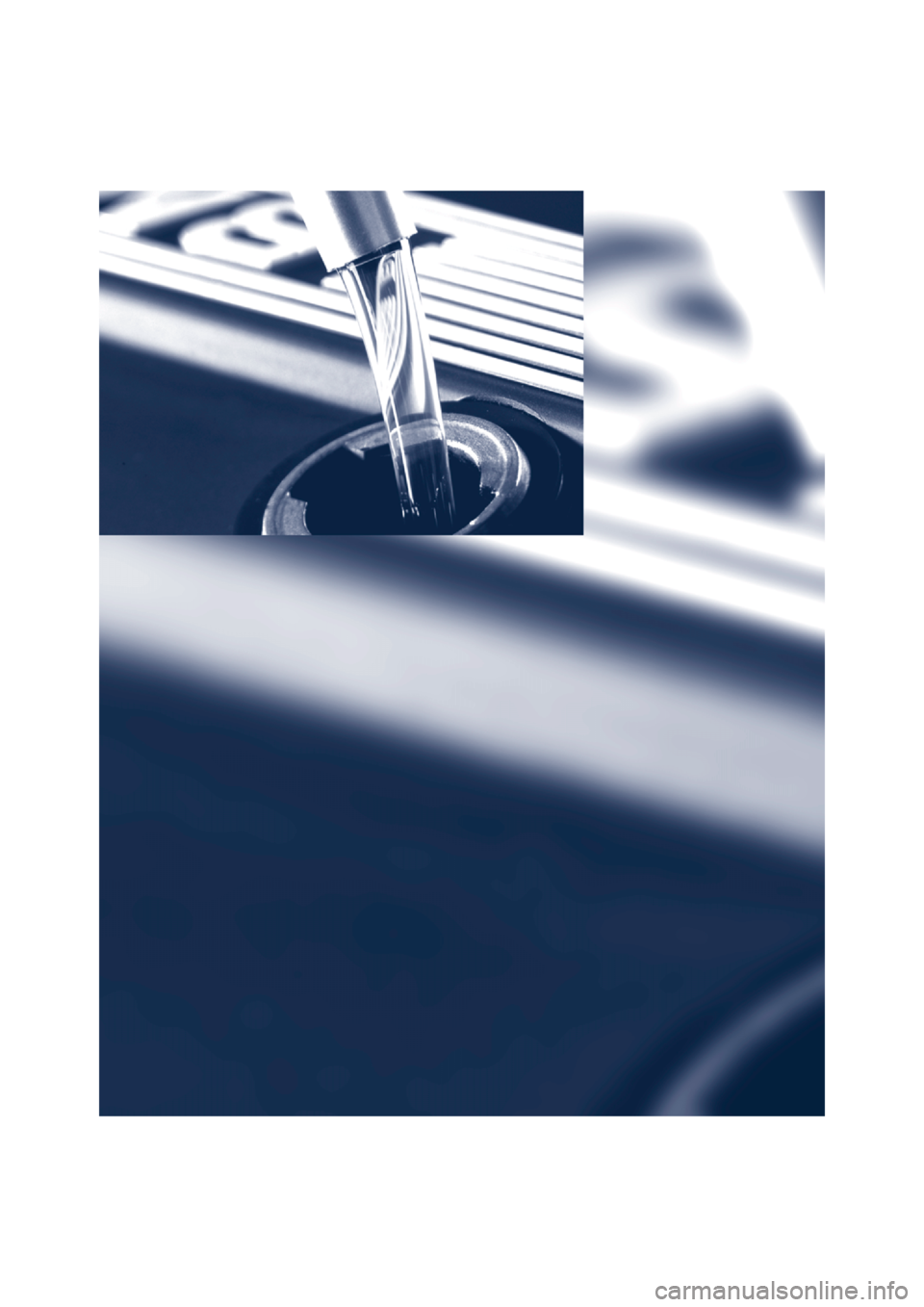
Page 213 of 272
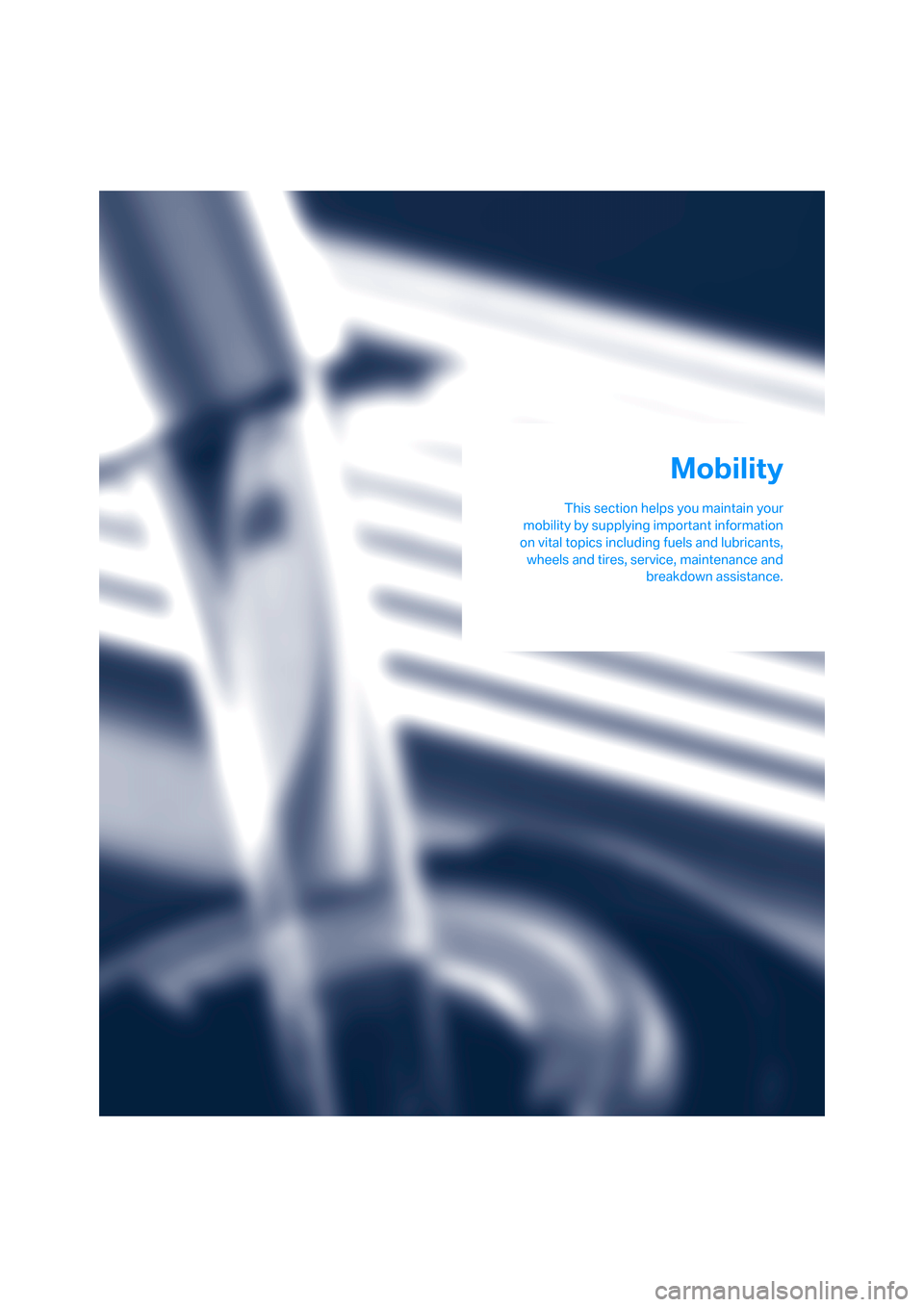
Mobility
This section helps you maintain your
mobility by supplying important information
on vital topics including fuels and lubricants,
wheels and tires, service, maintenance and
breakdown assistance.
Mobility
Page 214 of 272
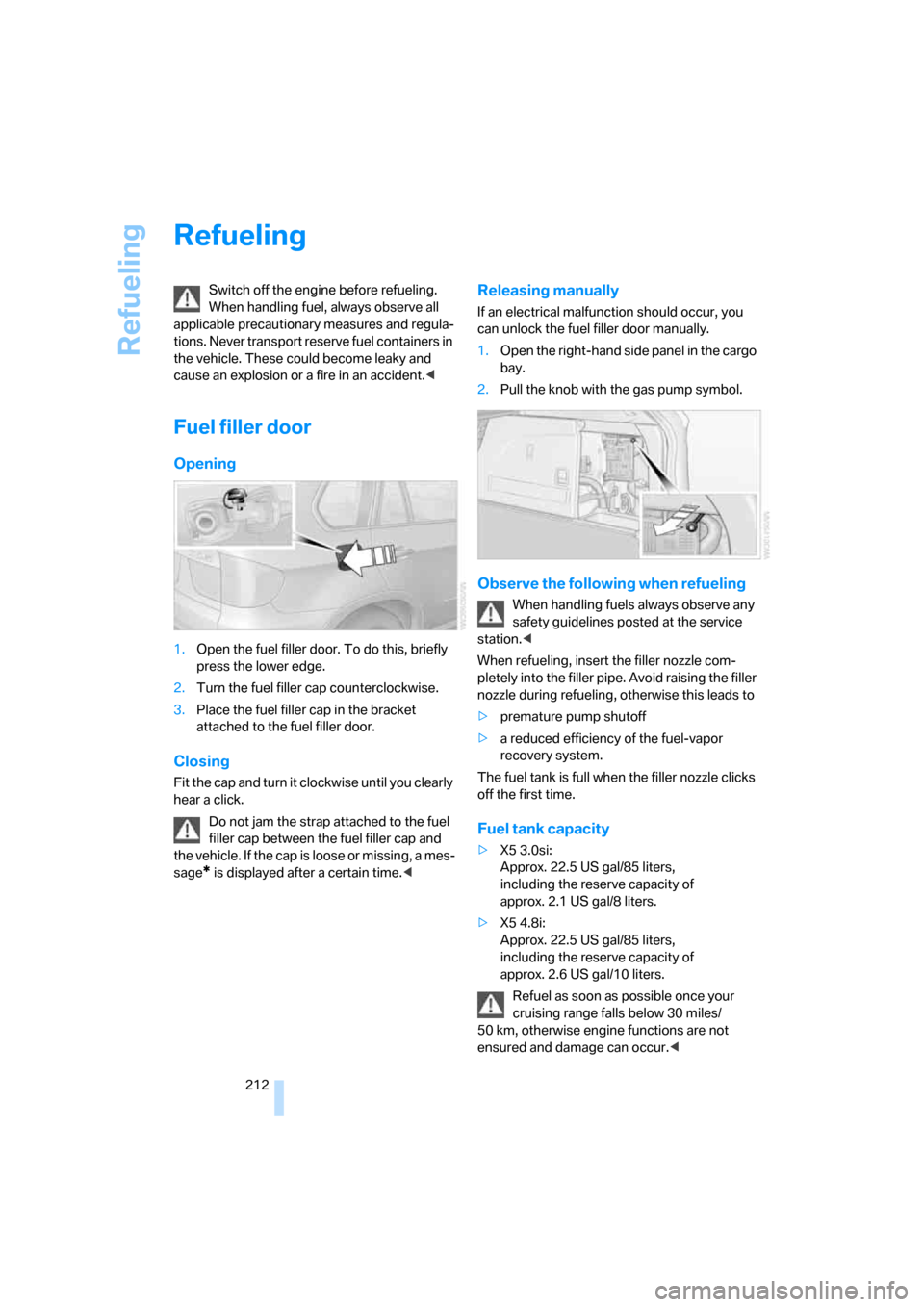
Refueling
212
Refueling
Switch off the engine before refueling.
When handling fuel, always observe all
applicable precautionary measures and regula-
tions. Never transport reserve fuel containers in
the vehicle. These could become leaky and
cause an explosion or a fire in an accident.<
Fuel filler door
Opening
1.Open the fuel filler door. To do this, briefly
press the lower edge.
2.Turn the fuel filler cap counterclockwise.
3.Place the fuel filler cap in the bracket
attached to the fuel filler door.
Closing
Fit the cap and turn it clockwise until you clearly
hear a click.
Do not jam the strap attached to the fuel
filler cap between the fuel filler cap and
the vehicle. If the cap is loose or missing, a mes-
sage
* is displayed after a certain time.<
Releasing manually
If an electrical malfunction should occur, you
can unlock the fuel filler door manually.
1.Open the right-hand side panel in the cargo
bay.
2.Pull the knob with the gas pump symbol.
Observe the following when refueling
When handling fuels always observe any
safety guidelines posted at the service
station.<
When refueling, insert the filler nozzle com-
pletely into the filler pipe. Avoid raising the filler
nozzle during refueling, otherwise this leads to
>premature pump shutoff
>a reduced efficiency of the fuel-vapor
recovery system.
The fuel tank is full when the filler nozzle clicks
off the first time.
Fuel tank capacity
>X5 3.0si:
Approx. 22.5 US gal/85 liters,
including the reserve capacity of
approx. 2.1 US gal/8 liters.
>X5 4.8i:
Approx. 22.5 US gal/85 liters,
including the reserve capacity of
approx. 2.6 US gal/10 liters.
Refuel as soon as possible once your
cruising range falls below 30 miles/
50 km, otherwise engine functions are not
ensured and damage can occur.<
Page 215 of 272
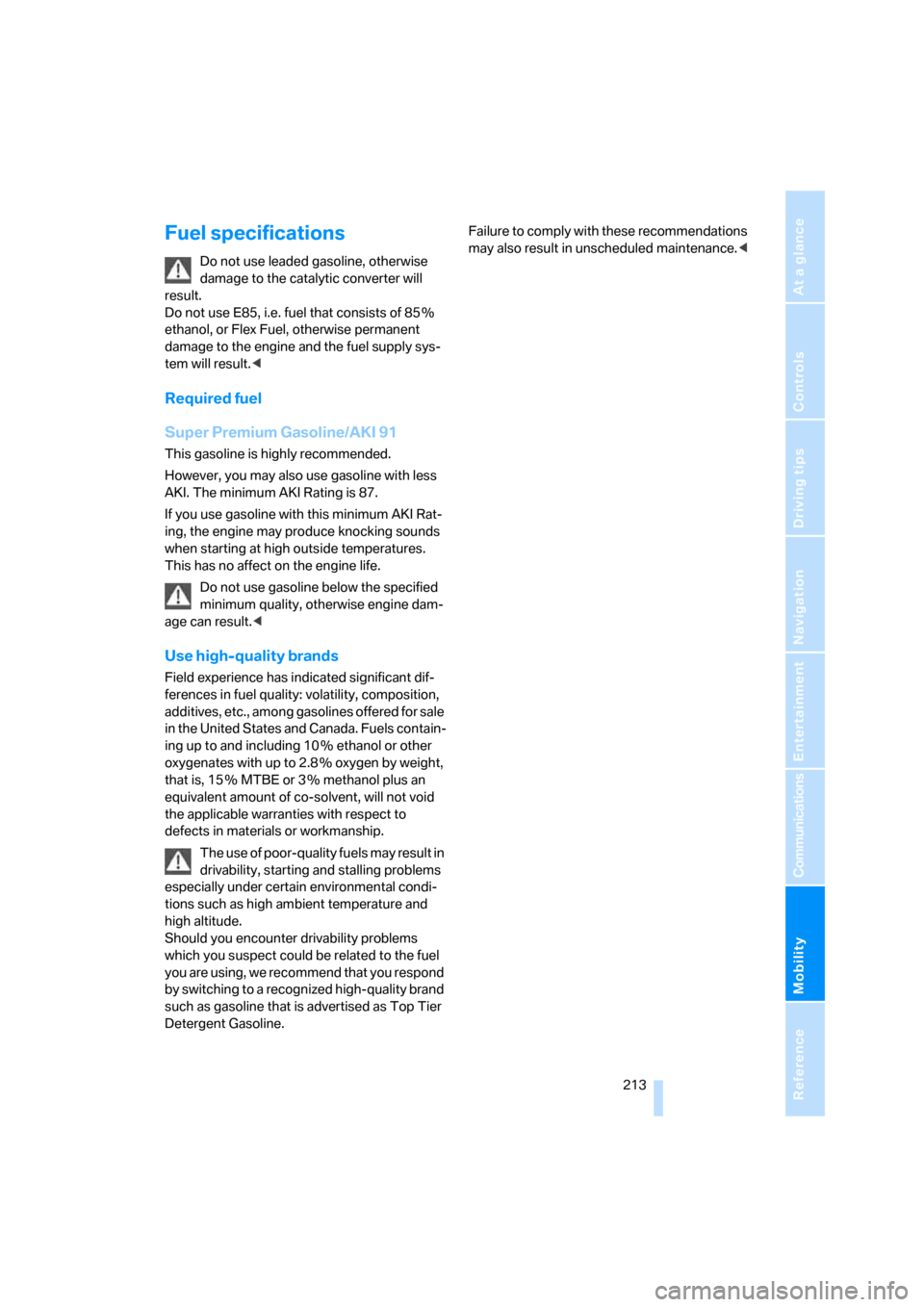
Mobility
213Reference
At a glance
Controls
Driving tips
Communications
Navigation
Entertainment
Fuel specifications
Do not use leaded gasoline, otherwise
damage to the catalytic converter will
result.
Do not use E85, i.e. fuel that consists of 85 %
ethanol, or Flex Fuel, otherwise permanent
damage to the engine and the fuel supply sys-
tem will result.<
Required fuel
Super Premium Gasoline/AKI 91
This gasoline is highly recommended.
However, you may also use gasoline with less
AKI. The minimum AKI Rating is 87.
If you use gasoline with this minimum AKI Rat-
ing, the engine may produce knocking sounds
when starting at high outside temperatures.
This has no affect on the engine life.
Do not use gasoline below the specified
minimum quality, otherwise engine dam-
age can result.<
Use high-quality brands
Field experience has indicated significant dif-
ferences in fuel quality: volatility, composition,
additives, etc., among gasolines offered for sale
in the United States and Canada. Fuels contain-
ing up to and including 10 % ethanol or other
oxygenates with up to 2.8 % oxygen by weight,
that is, 15 % MTBE or 3 % methanol plus an
equivalent amount of co-solvent, will not void
the applicable warranties with respect to
defects in materials or workmanship.
The use of poor-quality fuels may result in
drivability, starting and stalling problems
especially under certain environmental condi-
tions such as high ambient temperature and
high altitude.
Should you encounter drivability problems
which you suspect could be related to the fuel
you are using, we recommend that you respond
by switching to a recognized high-quality brand
such as gasoline that is advertised as Top Tier
Detergent Gasoline.Failure to comply with these recommendations
may also result in unscheduled maintenance.<
Page 216 of 272
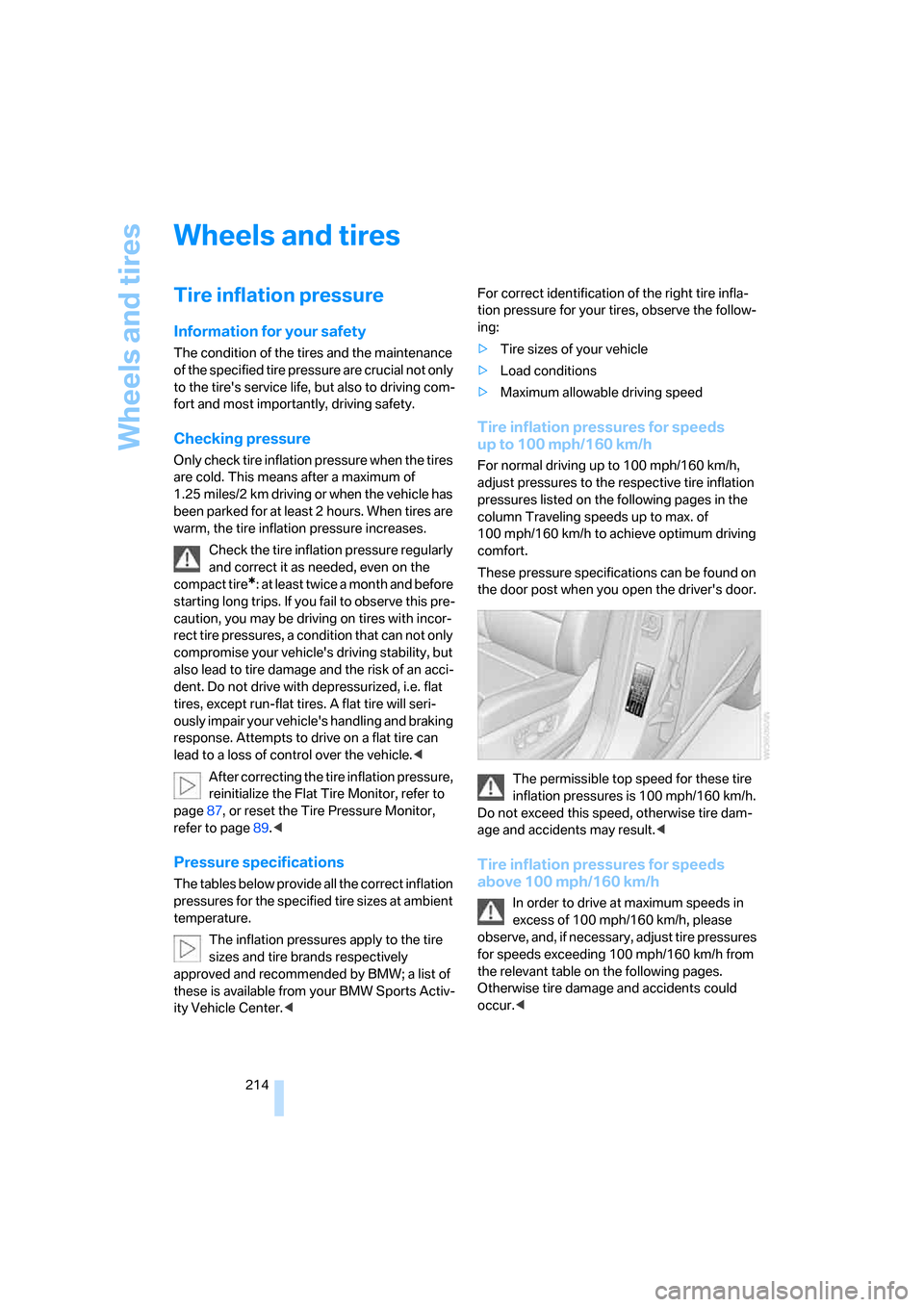
Wheels and tires
214
Wheels and tires
Tire inflation pressure
Information for your safety
The condition of the tires and the maintenance
of the specified tire pressure are crucial not only
to the tire's service life, but also to driving com-
fort and most importantly, driving safety.
Checking pressure
Only check tire inflation pressure when the tires
are cold. This means after a maximum of
1.25 miles/2 km driving or when the vehicle has
been parked for at least 2 hours. When tires are
warm, the tire inflation pressure increases.
Check the tire inflation pressure regularly
and correct it as needed, even on the
compact tire
*: at least twice a month and before
starting long trips. If you fail to observe this pre-
caution, you may be driving on tires with incor-
rect tire pressures, a condition that can not only
compromise your vehicle's driving stability, but
also lead to tire damage and the risk of an acci-
dent. Do not drive with depressurized, i.e. flat
tires, except run-flat tires. A flat tire will seri-
ously impair your vehicle's handling and braking
response. Attempts to drive on a flat tire can
lead to a loss of control over the vehicle.<
After correcting the tire inflation pressure,
reinitialize the Flat Tire Monitor, refer to
page87, or reset the Tire Pressure Monitor,
refer to page89.<
Pressure specifications
The tables below provide all the correct inflation
pressures for the specified tire sizes at ambient
temperature.
The inflation pressures apply to the tire
sizes and tire brands respectively
approved and recommended by BMW; a list of
these is available from your BMW Sports Activ-
ity Vehicle Center.
ing:
>Tire sizes of your vehicle
>Load conditions
>Maximum allowable driving speed
Tire inflation pressures for speeds
up to 100 mph/160 km/h
For normal driving up to 100 mph/160 km/h,
adjust pressures to the respective tire inflation
pressures listed on the following pages in the
column Traveling speeds up to max. of
100 mph/160 km/h to achieve optimum driving
comfort.
These pressure specifications can be found on
the door post when you open the driver's door.
The permissible top speed for these tire
inflation pressures is 100 mph/160 km/h.
Do not exceed this speed, otherwise tire dam-
age and accidents may result.<
Tire inflation pressures for speeds
above 100 mph/160 km/h
In order to drive at maximum speeds in
excess of 100 mph/160 km/h, please
observe, and, if necessary, adjust tire pressures
for speeds exceeding 100 mph/160 km/h from
the relevant table on the following pages.
Otherwise tire damage and accidents could
occur.<
Page 217 of 272
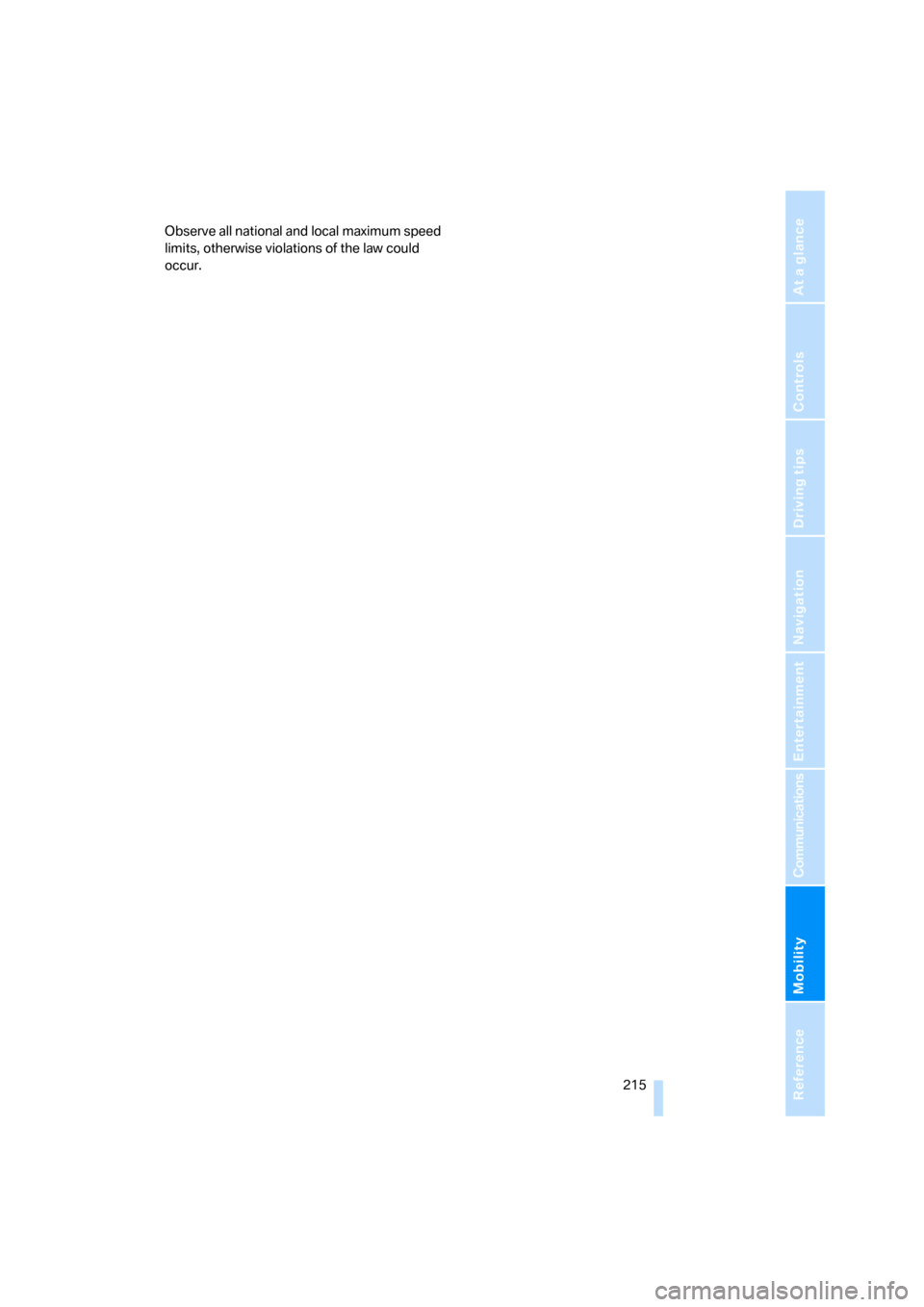
Mobility
215Reference
At a glance
Controls
Driving tips
Communications
Navigation
Entertainment
Observe all national and local maximum speed
limits, otherwise violations of the law could
occur.
Page 218 of 272
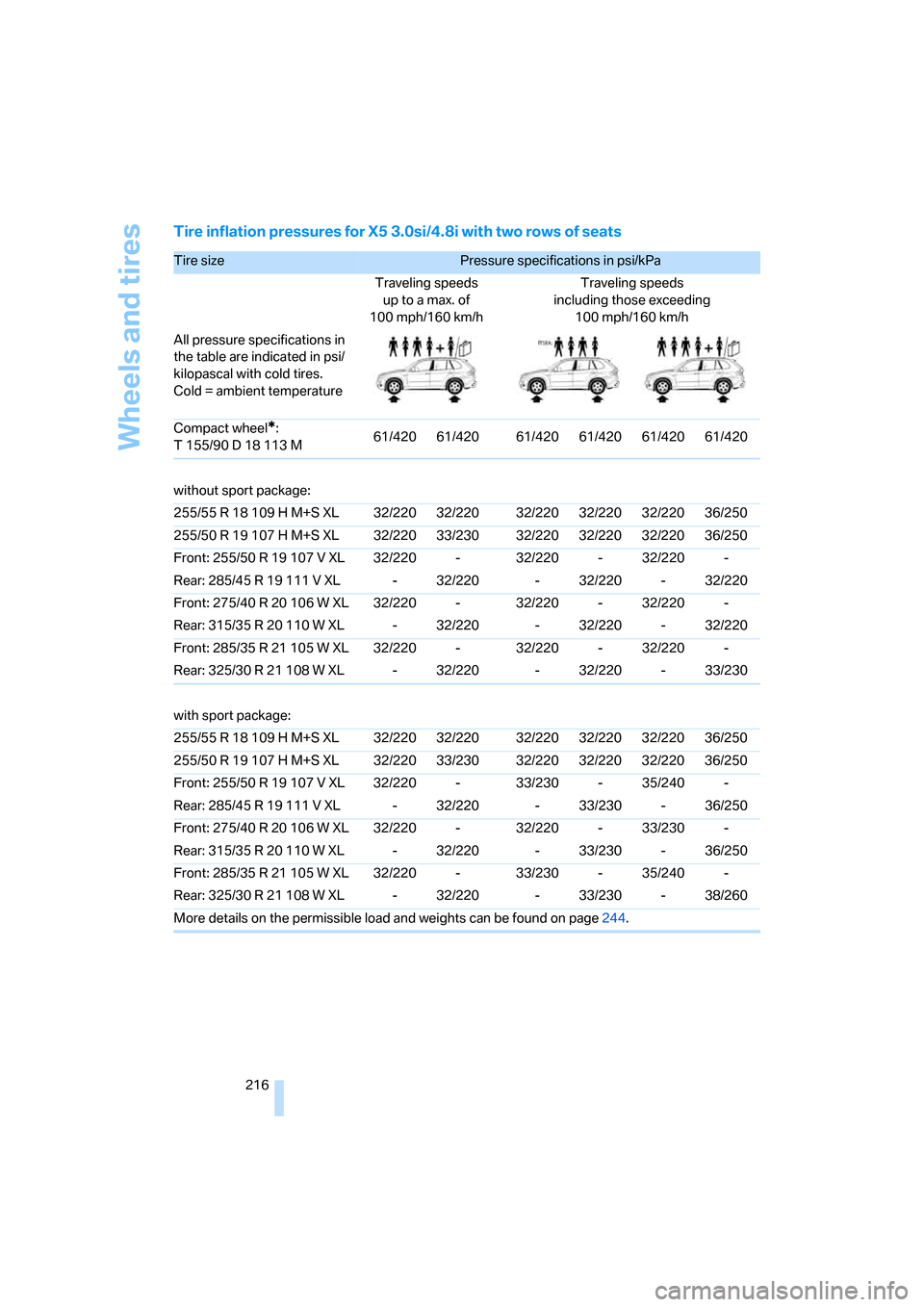
Wheels and tires
216
Tire inflation pressures for X5 3.0si/4.8i with two rows of seats
Tire size Pressure specifications in psi/kPa
Traveling speeds
up to a max. of
100 mph/160 km/hTraveling speeds
including those exceeding
100 mph/160 km/h
All pressure specifications in
the table are indicated in psi/
kilopascal with cold tires.
Cold = ambient temperature
Compact wheel
*:
T 155/90 D 18 113 M61/420 61/420 61/420 61/420 61/420 61/420
without sport package:
255/55 R 18 109 H M+S XL 32/220 32/220 32/220 32/220 32/220 36/250
255/50 R 19 107 H M+S XL 32/220 33/230 32/220 32/220 32/220 36/250
Front: 255/50 R 19 107 V XL 32/220 - 32/220 - 32/220 -
Rear: 285/45 R 19 111 V XL - 32/220 - 32/220 - 32/220
Front: 275/40 R 20 106 W XL 32/220 - 32/220 - 32/220 -
Rear: 315/35 R 20 110 W XL - 32/220 - 32/220 - 32/220
Front: 285/35 R 21 105 W XL 32/220 - 32/220 - 32/220 -
Rear: 325/30 R 21 108 W XL - 32/220 - 32/220 - 33/230
with sport package:
255/55 R 18 109 H M+S XL 32/220 32/220 32/220 32/220 32/220 36/250
255/50 R 19 107 H M+S XL 32/220 33/230 32/220 32/220 32/220 36/250
Front: 255/50 R 19 107 V XL 32/220 - 33/230 - 35/240 -
Rear: 285/45 R 19 111 V XL - 32/220 - 33/230 - 36/250
Front: 275/40 R 20 106 W XL 32/220 - 32/220 - 33/230 -
Rear: 315/35 R 20 110 W XL - 32/220 - 33/230 - 36/250
Front: 285/35 R 21 105 W XL 32/220 - 33/230 - 35/240 -
Rear: 325/30 R 21 108 W XL - 32/220 - 33/230 - 38/260
More details on the permissible load and weights can be found on page244.
Page 219 of 272
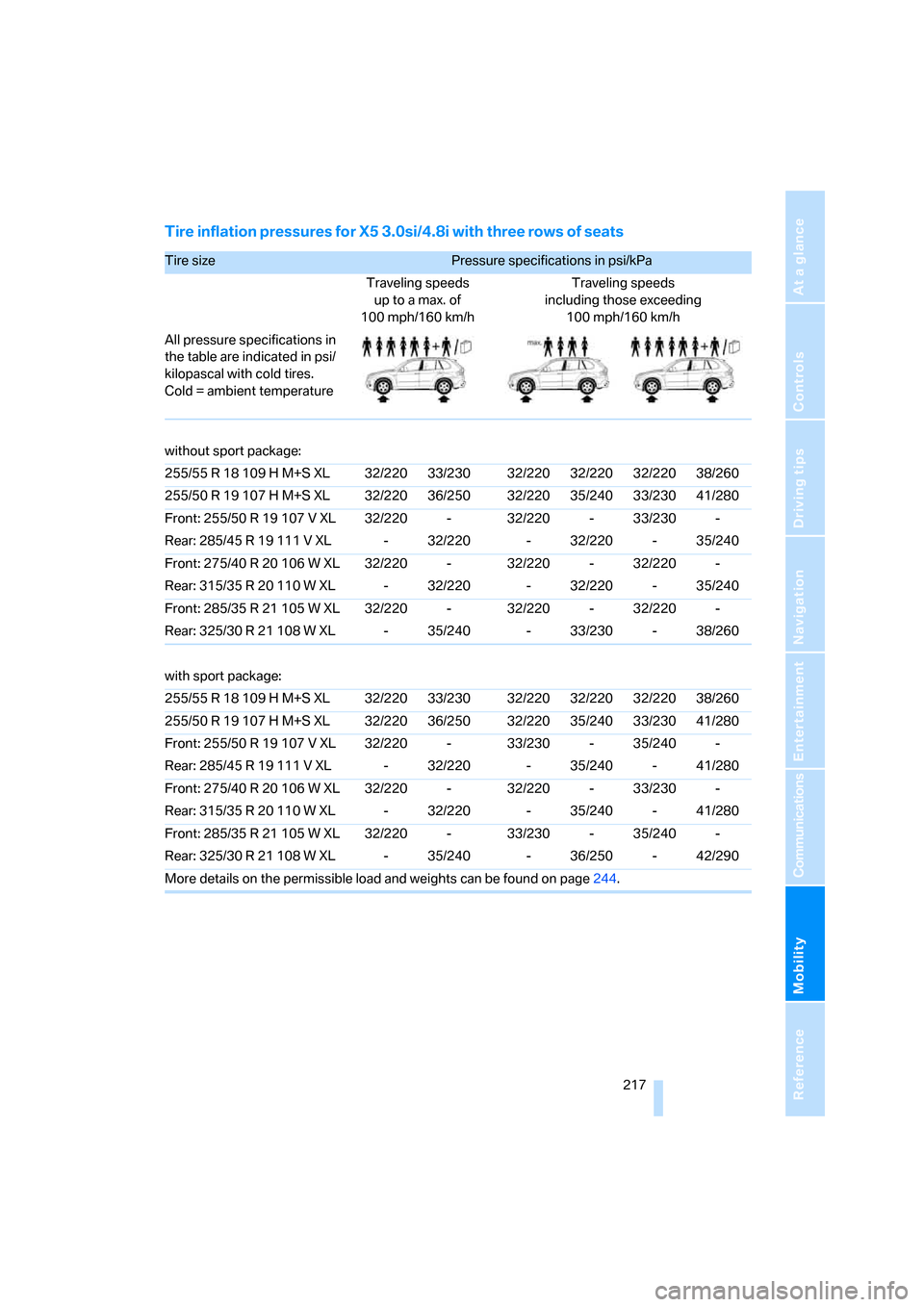
Mobility
217Reference
At a glance
Controls
Driving tips
Communications
Navigation
Entertainment
Tire inflation pressures for X5 3.0si/4.8i with three rows of seats
Tire size Pressure specifications in psi/kPa
Traveling speeds
up to a max. of
100 mph/160 km/hTraveling speeds
including those exceeding
100 mph/160 km/h
All pressure specifications in
the table are indicated in psi/
kilopascal with cold tires.
Cold = ambient temperature
without sport package:
255/55 R 18 109 H M+S XL 32/220 33/230 32/220 32/220 32/220 38/260
255/50 R 19 107 H M+S XL 32/220 36/250 32/220 35/240 33/230 41/280
Front: 255/50 R 19 107 V XL 32/220 - 32/220 - 33/230 -
Rear: 285/45 R 19 111 V XL - 32/220 - 32/220 - 35/240
Front: 275/40 R 20 106 W XL 32/220 - 32/220 - 32/220 -
Rear: 315/35 R 20 110 W XL - 32/220 - 32/220 - 35/240
Front: 285/35 R 21 105 W XL 32/220 - 32/220 - 32/220 -
Rear: 325/30 R 21 108 W XL - 35/240 - 33/230 - 38/260
with sport package:
255/55 R 18 109 H M+S XL 32/220 33/230 32/220 32/220 32/220 38/260
255/50 R 19 107 H M+S XL 32/220 36/250 32/220 35/240 33/230 41/280
Front: 255/50 R 19 107 V XL 32/220 - 33/230 - 35/240 -
Rear: 285/45 R 19 111 V XL - 32/220 - 35/240 - 41/280
Front: 275/40 R 20 106 W XL 32/220 - 32/220 - 33/230 -
Rear: 315/35 R 20 110 W XL - 32/220 - 35/240 - 41/280
Front: 285/35 R 21 105 W XL 32/220 - 33/230 - 35/240 -
Rear: 325/30 R 21 108 W XL - 35/240 - 36/250 - 42/290
More details on the permissible load and weights can be found on page244.
Page 220 of 272
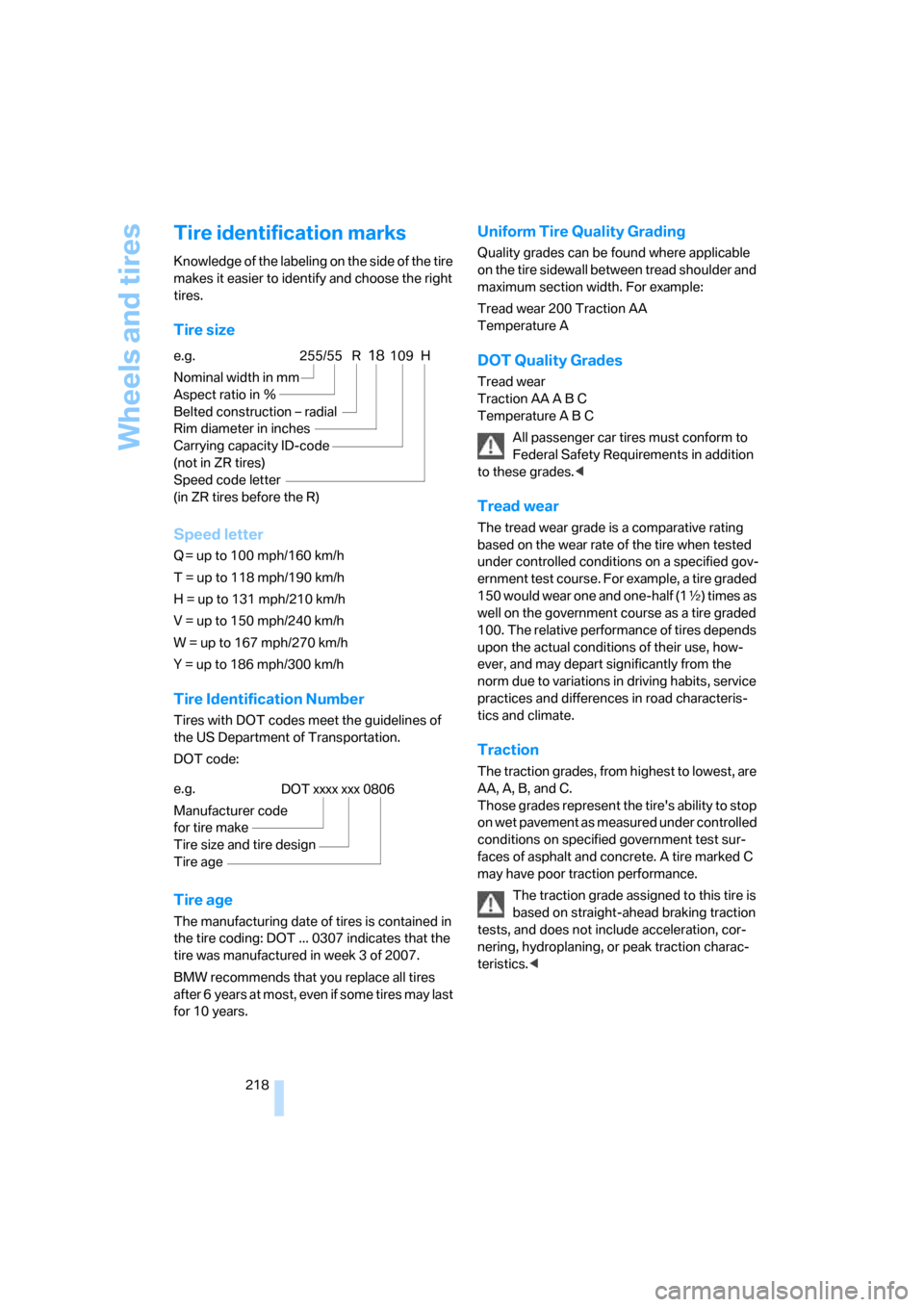
Wheels and tires
218
Tire identification marks
Knowledge of the labeling on the side of the tire
makes it easier to identify and choose the right
tires.
Tire size
Speed letter
Q = up to 100 mph/160 km/h
T = up to 118 mph/190 km/h
H = up to 131 mph/210 km/h
V = up to 150 mph/240 km/h
W = up to 167 mph/270 km/h
Y = up to 186 mph/300 km/h
Tire Identification Number
Tires with DOT codes meet the guidelines of
the US Department of Transportation.
DOT code:
Tire age
The manufacturing date of tires is contained in
the tire coding: DOT ... 0307 indicates that the
tire was manufactured in week 3 of 2007.
BMW recommends that you replace all tires
after 6 years at most, even if some tires may last
for 10 years.
Uniform Tire Quality Grading
Quality grades can be found where applicable
on the tire sidewall between tread shoulder and
maximum section width. For example:
Tread wear 200 Traction AA
Temperature A
DOT Quality Grades
Tread wear
Traction AA A B C
Temperature A B C
All passenger car tires must conform to
Federal Safety Requirements in addition
to these grades.<
Tread wear
The tread wear grade is a comparative rating
based on the wear rate of the tire when tested
under controlled conditions on a specified gov-
ernment test course. For example, a tire graded
150 would wear one and one-half (1γ) times as
well on the government course as a tire graded
100. The relative performance of tires depends
upon the actual conditions of their use, how-
ever, and may depart significantly from the
norm due to variations in driving habits, service
practices and differences in road characteris-
tics and climate.
Traction
The traction grades, from highest to lowest, are
AA, A, B, and C.
Those grades represent the tire's ability to stop
on wet pavement as measured under controlled
conditions on specified government test sur-
faces of asphalt and concrete. A tire marked C
may have poor traction performance.
The traction grade assigned to this tire is
based on straight-ahead braking traction
tests, and does not include acceleration, cor-
nering, hydroplaning, or peak traction charac-
teristics.< e.g.
Nominal width in mm
Aspect ratio in Ξ
Belted construction – radial
Rim diameter in inches
Carrying capacity ID-code
(not in ZR tires)
Speed code letter
(in ZR tires before the R)
255/55 R18109 H
e.g.
Manufacturer code
for tire make
Tire size and tire design
Tire ageDOT xxxx xxx 0806